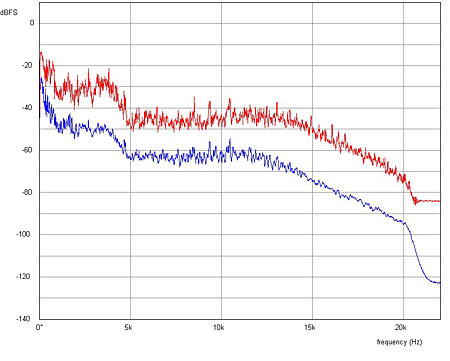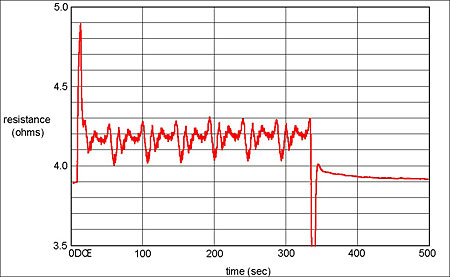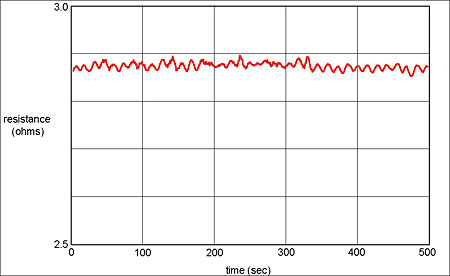| Columns Retired Columns & Blogs |
Hot Stuff: Loudspeaker Voice-Coil Temperatures Page 2
A current source, by contrast, has an output impedance that is large compared to the load impedance, so that now its output current is largely unaffected by fluctuations in load impedance. This is significant in the context of thermal compression because it is the current through the voice-coil that generates the driver's motive force. If this is unaffected by changes in voice-coil resistance, then thermal compression cannot occur.
Footnote 1: P.G.L. Mills and M.O.J. Hawksford, "Distortion Reduction in Moving-Coil Loudspeaker Systems Using Current-Drive Technology," JAES, Vol.37 No.3, March 1989 (obtainable as download or hard copy from the AES).
The trouble is, you can't simply substitute a current-source amplifier for a voltage-source amplifier when the loudspeaker expects to see a voltage source. The high output impedance of the current source means that any variation in the speaker's input impedance will be reflected in the voltage developed across its terminals, and this will directly affect the speaker's frequency response. (See "Questions of Impedance Interaction.")
This hurdle to their wider usage notwithstanding, current-source amplifiers have their protagonists. As is usually the case in audio, the history of current-source amplification probably goes back a long way—longer than I know. My interest in it began with a paper by Malcolm Omar Hawksford and Paul Mills, published in 1989 in the Journal of the Audio Engineering Society, describing research that had been assisted by Celestion (footnote 1). As well as investigating the advantages of current drive—the principal one being the elimination of voice-coil heating as a factor in speaker performance—the paper also considered ways in which current drive might be implemented.
Although the Hawksford-Mills paper did not inspire any sea change in mainstream audio practice, there remains a background level of interest in this means of driving loudspeakers. This has been boosted in recent years by the indefatigable Nelson Pass, whose "kitchen table" F1 and F2 amplifiers were both (quasi-)current-source designs (the F2 somewhat less so), and who has written on the subject of current drive for audioXpress (footnote 2). When someone with a track record like Pass's becomes interested in an offbeat idea, we should all take notice—the more so as both the F1 and F2 have received enthusiastic reviews (from Art Dudley, for one, in the January 2005 Stereophile).
But it isn't the purpose of this article to consider the merits of current drive, other than to mention its potential to counter thermal compression. Instead, I want to take a closer look at voice-coil heating as it affects typical domestic speakers playing music at typical domestic listening levels. Much of the literature on thermal compression relates principally to professional public-address applications, where the requirements of high amplifier power and sound-pressure level make it a particular problem (footnotes 3, 4). I have found very little published about the voice-coil temperatures achieved in hi-fi loudspeakers under normal conditions of use. And yet, without this information it isn't possible to make any meaningful assessment of whether thermal compression is a significant or peripheral issue to you and me, and whether the means of obviating it are therefore of any more than academic interest.
Finding out
To shed some light on this, I would have to perform the necessary measurements myself, and that was going to involve building some bespoke instrumentation—devices for measuring voice-coil resistance in the presence of a music signal are not available off the shelf. For those interested in the details, the circuit I came up with is described in the sidebar, "Making the Measurements."
Here let's concentrate on the results, which I obtained using a (discontinued) B&W CDM1NT as the subject loudspeaker. I chose this model for three reasons:
1) You would expect thermal-compression problems to be at their worst in compact two-way speakers of lower than average sensitivity. Certainly there are smaller and less sensitive high-quality speakers than the CDM1NT, but it represents a fair benchmark in this respect. If the CDM1NT is unaffected by serious thermal compression at normal listening levels, then that should be true of most hi-fi loudspeakers.
2) I had a CDM1NT from which the crossover boards had been removed, which allowed measurement of the voice-coil temperatures of both the bass-midrange driver and the tweeter. As the crossover's high-pass filter network usually includes a series capacitor, and as the resistance-measurement method uses a DC-sensing current, the tweeter's thermal behavior cannot be measured unless it can be accessed downstream of the crossover.
3) As you will have surmised from (2), I own this speaker. In the event of a measurement-equipment snafu causing a terminal accident, I wouldn't have to make that humble-pie phone call about an unwell loan sample.
The next task was to select program material likely to most effectively heat the speaker's voice-coils. I have it on the good authority of Meridian's Bob Stuart that Metallica tracks make for good power-testing material, as they have negligible dynamic range and quite a wide frequency spectrum. Heavy metal not featuring much in my collection, I opted instead for Led Zeppelin II, which earns its place among my CDs for reasons of teenage nostalgia. The instrumental section in the latter half of "Heartbreaker" proved to be just what I was looking for, with a paucity of dynamic range to gladden any metalhead's heart, and quite a wide spectrum too (fig.2). As this excerpt lasts only about 47 seconds, I stitched seven repeats end to end in a WAV file to create a single track of over five minutes in length. I then combined the left and right channels to form a mono track, then converted that back to double-mono for burning to CD-R.

Fig.2 Peak (red trace) and average (blue) spectra of the Led Zeppelin II excerpt used for the testing. Note the wide frequency range and the close spacing of the two traces, which confirms the excerpt's low dynamic range.
Playback was via a Townshend TA565 universal player and a Rotel RA-1062 integrated amplifier rated at 60Wpc continuous into 8 ohms. The volume control was set to about 2 o'clock, at which the sound-pressure level at 1m driving the CDM1NT's bass-mid driver read between 100 and 104dB, and the cone was undergoing sufficiently large excursions to threaten the end-stops had the volume been much higher. Once I'd tested the bass-mid driver at this level, I measured the tweeter at the same volume setting.
Keeping cool
The results, shown in figs. 3 and 4, came as something of a surprise. Despite what rates as a high playback level for me and, I imagine, most Stereophile readers, I had anticipated there being only modest increases in voice-coil resistance. But the increases were even less than I'd expected.

Fig.3 Resistance vs time for the bass-midrange driver of the B&W CDM1NT. The trace begins and returns to a quiescent value of 3.9 ohms, rising to about 4.2 ohms while playing the test program.

Fig.4 As in fig.3, but for the CDM1NT's tweeter and with a zoomed vertical scale. Here the change in resistance when playing the test program is barely distinguishable, amounting to about 0.01 ohm.
Taking first the CDM1NT's bass-mid driver (fig.3), the trace begins at the voice-coil's quiescent 3.9 ohm resistance prior to the start of the music, which is indicated by the first large glitch (caused by the sudden start of the music interacting with the impulse response of the measurement equipment's 1Hz low-pass filter). This glitch hides the initial exponential rise of voice-coil resistance, which, just before the end of the test track, at around 340 seconds, reaches about 4.2 ohms, an increase of 8%. (Ignore the small ripples in the trace, which are caused by the transient nature of the music signal interacting with the filter; it's the average value we're concerned with here.) When the music finishes, a second, opposite polarity glitch hides the initial decay in voice-coil resistance, after which an exponential decay continues back to the 3.9 ohm initial value. Referring to fig.1, an 8% increase in resistance corresponds to a temperature increase of just under 20°C (36°F), and corresponds to a thermal compression of just 0.67dB. Had the test signal been played longer, the voice-coil resistance and the thermal compression may have risen a little higher, but not by much.
With the tweeter (fig.4), the resistance increase is barely visible on the trace, even with the vertical scale expanded to cover just half an ohm. It amounts to about 0.01 ohm and is utterly negligible in respect of thermal compression. This is due, first, to the significantly lower power delivered to the tweeter as a result of the declining high-frequency content of the test signal (and music in general). In fact, in this instance the tweeter receives only a little over 3% of the power delivered to the bass-mid unit. Secondarily, the CDM1NT's tweeter has the advantage of an aluminum dome and ferrofluid in its magnet gap to aid the dissipation of heat.
Of course, it would be possible to worsen these figures by driving the speaker still harder, but there would soon be objection from both the speaker and my ears. More realistically, on the wider-dynamic-range material I more usually listen to, and at my habitual replay levels, the rise in voice-coil temperature and the concomitant thermal compression will be lower still. So I strongly suspect that, for most hi-fi users—those who don't habitually wind the volume control to its highest position and indulge in PA listening levels—thermal compression is a paper tiger. To be absolutely certain that it doesn't interfere in any way with subtle dynamic contrasts, it would be necessary to use the data from resistance vs time measurements to construct a thermal model of each drive-unit, then write software to apply the appropriate thermal compression to a source file (or, perhaps better, undo it) for the purposes of comparison.
That, maybe, is a project for the future. Right now, the prospect of thermal compression in my listening-room loudspeakers causes me no lost sleep whatsoever.
Footnote 1: P.G.L. Mills and M.O.J. Hawksford, "Distortion Reduction in Moving-Coil Loudspeaker Systems Using Current-Drive Technology," JAES, Vol.37 No.3, March 1989 (obtainable as download or hard copy from the AES).
Footnote 2 Pass's two articles can be downloaded from www.firstwatt.com.
Footnote 3 M.R. Gander, "Dynamic Linearity and Power Compression in Moving-Coil Loudspeakers," JAES, Vol.34 No.9, September 1986.
Footnote 4 D.J. Button, "Heat Dissipation and Power Compression in Loudspeakers," JAES, Vol.40 Nos.1/2, January/February 1992.
- Log in or register to post comments




































